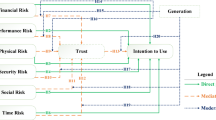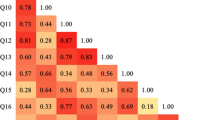Abstract
In China, there are no road rights for personal mobility vehicles (PMVs), but sales of PMVs in China are rapidly increasing, and at present, a large group of PMV users has been formed. Research on the demand and intentions of PMV users holds great significance for road safety and policy formulation. This research adopts an online questionnaire based on the unified theory of acceptance and use of technology model and introduces perceived risk, product satisfaction, and policy measures to construct a model of the impact mechanism of user intentions to ride PMVs on the road. First, a questionnaire survey was conducted among 418 PMV users in China, and the factors affecting their intentions to ride PMVs on the road were analyzed through structural equation modeling (SEM). The results from analyzing the questionnaires show that performance expectancy, effort expectancy, social influence, perceived risk and policy measures have a significant positive impact on user intentions to ride PMVs on the road. However, product satisfaction has no significant impact on user intentions to ride PMVs on the road, but through risk perception, it has a mediating effect on user intentions. In addition, there are four adjustment variables: gender, age, educational level and experience witnessing others riding PMVs on the road. The results of multigroup SEM analysis show that there are significant differences in the path of user intentions to ride PMVs on the road. Second, compared with other surveys obtained from the Internet among 307 non-users and non-owners of PMVs, there are significant differences in perceived risk, policy measures and intentions to ride PMVs on the road. Implications for policy-making and suggestions for future research are discussed.




Similar content being viewed by others
Explore related subjects
Discover the latest articles, news and stories from top researchers in related subjects.References
Ajisaka S, Kubota T, Hashimoto H (2013) Human balance control ability for affinitive personal vehicle. In: IEEE 10th international conference on ubiquitous robots and ambient intelligence (URAI). pp 503–508
Ando R, Li A (2012) An analysis on users’ evaluation for self-balancing two-wheeled personal mobility vehicles. In: 15th international IEEE conference on intelligent transportation systems. pp 1525–1530
Ando R, Li A, Nishihori Y, Kachi N (2013) Acceptability of personal mobility vehicles to public in Japan: Results of social trial in Toyota city. In: Spatial planning and sustainable development. Springer, Dordrecht, pp 213–225
Campbell AA, Cherry CR, Ryerson MS, Yang X (2016) Factors influencing the choice of shared bicycles and shared electric bikes in Beijing. Transport Res Part C Emerg Technol 67:399–414
Chantala K, Suchindran C, Blanchette D (2006) Adjusting for unequal selection probability in multilevel models: a comparison of software packages. In: Proceedings of the American Statistical Association. American Statistical Association, Seattle, pp 2815–2824
Cicchetti DV (1994) Guidelines, criteria, and rules of thumb for evaluating normed and standardized assessment instruments in psychology. Psychol Assess 6(4):284
Dias C, Iryo M, Nishiuchi H (2017) Evaluation of safe avoidance distance for pedestrians in personal mobility vehicles and pedestrian mixed traffic: a simulation based study. J East Asia Soc Transp Stud 12:1994–2005
Dias C, Nishiuchi H, Hyoudo S, Todoroki T (2018) Simulating interactions between pedestrians, Segway riders and cyclists in shared spaces using social force model. Transp Res Procedia 34:91–98
Diekmann M, Theuvsen L (2019) Non-participants interest in CSA-insights from Germany. J Rural Stud 69:1–10
Du H, Liu D, Sovacool BK, Wang Y, Ma S, Li RYM (2018) Who buys new energy vehicles in China? Assessing social-psychological predictors of purchasing awareness, intention, and policy. Transport Res Part F Traffic Psychol Behav 58:56–69
Fang K, Handy S (2019) Skateboarding for transportation: exploring the factors behind an unconventional mode choice among university skateboard commuters. Transportation 46(1):263–283
Farah H, Koutsopoulos HN, Saifuzzaman M, Kölbl R, Fuchs S, Bankosegger D (2012) Evaluation of the effect of cooperative infrastructure-to-vehicle systems on driver behavior. Transport Res Part C Emerg Technol 21(1):42–56
General Administration of Quality Supervision (2017) National Standard of PMV. http://www.aqsiq.gov.cn/zjxw/dfzjxw/dfftpxw/201712/t20171215_508954.htm. Accessed 15 Dec 2017
Guo Y, Li Z, Wu Y, Xu C (2018) Evaluating factors affecting electric bike users’ registration of license plate in China using Bayesian approach. Transport Res Part F Traffic Psychol Behav 59:212–221
Guo Y, Sayed T, Zaki MH (2019) Evaluating the safety impacts of powered two wheelers on a shared roadway in China using automated video analysis. J Transp Saf Secur 11(4):414–429
Hasegawa Y, Dias C, Iryo-Asano M, Nishiuchi H (2018) Modeling pedestrians’ subjective danger perception toward personal mobility vehicles. Transport Res Part F Traffic Psychol Behav 56:256–267
Huang GQ, Chen X (2017) A study on the intention of bike-sharing usage based on context awareness theory an UTAUT model. Consum Econ 33(3):62–68
Huang X, Ge J (2019) Electric vehicle development in Beijing: an analysis of consumer purchase intention. J Clean Prod 216:361–372
Hulse LM, Xie H, Galea ER (2018) Perceptions of autonomous vehicles: relationships with road users, risk, gender and age. Saf Sci 102:1–13
Im I, Hong S, Kang MS (2011) An international comparison of technology adoption: testing the UTAUT model. Inf Manag 48(1):1–8
Iryo T, Kusakabe T, Yamanaka I, Asakura Y (2013) Effect on travelers’ activities and environmental impacts by introducing a next-generation personal transport system in a city. Int J Sustain Transp 7(3):226–237
Khazaei H, Khazaei A (2016) Electric vehicles and factors that influencing their adoption moderating effects of driving experience and voluntariness of use (conceptual framework). J Bus Manag 18(12):60–65
Lai WT, Chen CF (2011) Behavioral intentions of public transit passengers—the roles of service quality, perceived value, satisfaction and involvement. Transp Policy 18(2):318–325
Li A, Ando R (2013) Measuring the acceptability of self-balancing two-wheeled personal mobility vehicles. J East Asia Soc Transport Stud 10:444–453
Liu K, Asakura Y (2009) Willingness-to-pay for the low speed private transportation mode (LSPTM) system: a web-based stated preference survey. In: 12th International Conference on Travel Behaviour Research, Jaipur, Rajasthan, India
Madigan R, Louw T, Dziennus M, Graindorge T, Ortega E, Graindorge M, Merat N (2016) Acceptance of automated road transport systems (ARTS): an adaptation of the UTAUT model. Transport Res Procedia 14:2217–2226
Madigan R, Louw T, Wilbrink M, Schieben A, Merat N (2017) What influences the decision to use automated public transport? Using UTAUT to understand public acceptance of automated road transport systems. Transport Res Part F Traffic Psychol Behav 50:55–64
Martin EW, Shaheen SA (2014) Evaluating public transit modal shift dynamics in response to bikesharing: a tale of two US cities. J Transp Geogr 41:315–324
Nakagawa C, Nakano K, Suda Y, Nabeshima K (2009) Proposal for personal mobility vehicle. Seisan-Kenkyu 61(1):71–74
National Bureau of Statistics (2019) Interpretation of May industrial production data by the industrial department of the national bureau of statistics. http://www.stats.gov.cn/tjsj/sjjd/201906/t20190614_1670402.html. Accessed 15 June 2019 (in Chinese)
Nishihori Y, Kawai M, Kachi N, Inagaki T, Ando R (2010) A discussion for introducing personal mobility vehicles into real society. In: Proceedings of 2010 JSAE Annual Congress (Autumn), vol 142, no 10, pp 23–26
Oye ND, Iahad NA, Rahim NA (2014) The history of UTAUT model and its impact on ICT acceptance and usage by academicians. Educ Inf Technol 19(1):251–270
Poulter DR, Chapman P, Bibby PA, Clarke DD, Crundall D (2008) An application of the theory of planned behaviour to truck driving behaviour and compliance with regulations. Accid Anal Prev 40(6):2058–2064
Rahman MM, Lesch MF, Horrey WJ, Strawderman L (2017) Assessing the utility of TAM, TPB, and UTAUT for advanced driver assistance systems. Accid Anal Prev 108:361–373
Sarstedt M, Ringle CM, Smith D, Reams R, Hair JF Jr (2014) Partial least squares structural equation modeling (PLS-SEM): a useful tool for family business researchers. J Fam Bus Strategy 5(1):105–115
Shaheen S, Chan N (2016) Mobility and the sharing economy: potential to facilitate the first-and last-mile public transit connections. Built Environ 42(4):573–588
Shaheen S, Rodier CJ (2008) Easyconnect: Low-speed modes linked to transit planning project. https://escholarship.org/uc/item/4w92s6nj. Accessed 1 Oct 2008
Shaheen S, Rodier C, Seelig J (2005) Easyconnect ii: integrating transportation, information, and energy technologies at transit oriented developments. https://escholarship.org/uc/item/9mc515hg. Accessed 14 May 2005
Sovacool BK, Kester J, Noel L, de Rubens GZ (2019) Are electric vehicles masculinized? Gender, identity, and environmental values in Nordic transport practices and vehicle-to-grid (V2G) preferences. Transport Res Part D Transp Environ 72:187–202
TaiHe Electric (2018) Solving the last kilometer problem: an analysis of the current situation of PMV in China, http://m.sohu.com/a/279156084_764272. Accessed 2 Dec 2018 (in Chinese)
Talukder MS, Shen L, Talukder MFH, Bao Y (2019) Determinants of user acceptance and use of open government data (OGD): an empirical investigation in Bangladesh. Technol Soc 56:147–156
Ulrich KT (2005) Estimating the technology frontier for personal electric vehicles. Transport Res Part C Emerg Technol 13(5–6):448–462
Vanderhaegen F (2014) Dissonance engineering: a new challenge to analyse risky knowledge when using a system. Int J Comput Commun Control 9(6):750–759
Vanderhaegen F (2016) Toward a petri net based model to control conflicts of autonomy between cyber-physical & human-systems. IFAC-PapersOnLine 49(32):36–41
Vanderhaegen F (2017) Towards increased systems resilience: new challenges based on dissonance control for human reliability in cyber-physical and human systems. Ann Rev Control 44:316–322
Vanderhaegen F, Carsten O (2017) Can dissonance engineering improve risk analysis of human–machine systems? Cogn Technol Work 19(1):1–12
Vanderhaegen F, Zieba S (2014) Reinforced learning systems based on merged and cumulative knowledge to predict human actions. Inf Sci 276(20):146–159
Venkatesh V, Morris MG, Ackerman PL (2000) A longitudinal field investigation of gender differences in individual technology adoption decision-making processes. Organ Behav Hum Decis Process 83(1):33–60
Venkatesh V, Morris MG, Davis GB, Davis FD (2003) User acceptance of information technology: toward a unified view. MIS Q 27(3):425–478
Wang YS, Shih YW (2009) Why do people use information kiosks? A validation of the unified theory of acceptance and use of technology. Gov Inf Q 26(1):158–165
Xu J, Shang S, Yu G, Qi H, Wang Y, Xu S (2016) Are electric self-balancing scooters safe in vehicle crash accidents? Accid Anal Prev 87:102–116
Zhou T, Lu Y, Wang B (2010) Integrating TTF and UTAUT to explain mobile banking user adoption. Comput Hum Behav 26(4):760–767
Zieba S, Polet P, Vanderhaegen F, Debernard S (2010) Principles of adjustable autonomy: a framework for resilient human–machine cooperation. Cogn Technol Work 12(3):193–203
Zmud JP, Sener IN (2017) Towards an understanding of the travel behavior impact of autonomous vehicles. Transport Res Procedia 25:2500–2519
Acknowledgements
This paper was supported by the National Natural Science Foundation of China, Young Scientists Fund (no. 51905142) and the Fundamental Research Funds for the Central Universities (no. JZ2017HGTB0209).
Author information
Authors and Affiliations
Corresponding author
Additional information
Publisher's Note
Springer Nature remains neutral with regard to jurisdictional claims in published maps and institutional affiliations.
Rights and permissions
About this article
Cite this article
Yu, Z., Feng, Z., Jiang, K. et al. Riding personal mobility vehicles on the road: an analysis of the intentions of Chinese users. Cogn Tech Work 22, 801–814 (2020). https://doi.org/10.1007/s10111-019-00617-9
Received:
Accepted:
Published:
Issue Date:
DOI: https://doi.org/10.1007/s10111-019-00617-9




